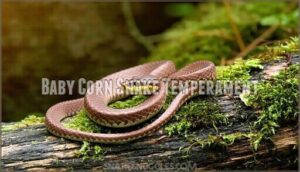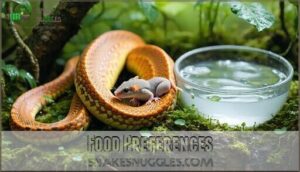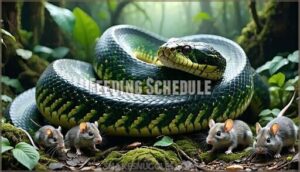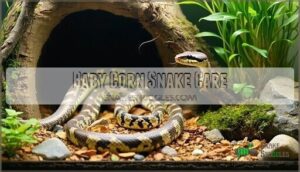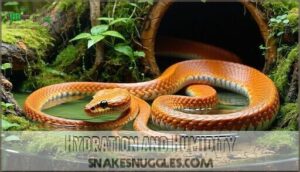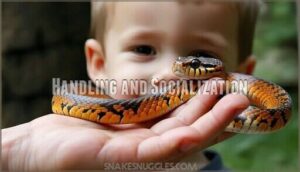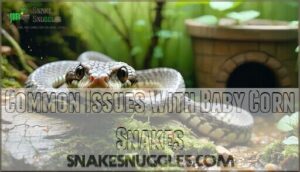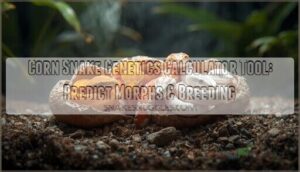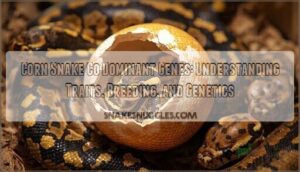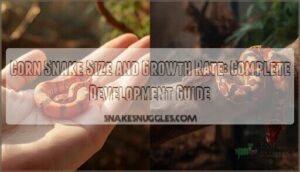This site is supported by our readers. We may earn a commission, at no cost to you, if you purchase through links.
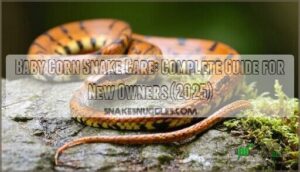
These 8-12 inch hatchlings won’t give you the cold shoulder like some pets might. You’ll need a secure 20-gallon tank since they’re Houdini-level escape artists.
Temperatures between 75-85°F, and appropriately-sized frozen mice every 5-7 days are necessary for their care. Baby corn snakes rarely bite and handle beautifully once they settle in.
They’ll shed every few weeks as they grow, displaying stunning colors from classic orange to exotic morphs like snow or lavender. Getting the feeding schedule right separates successful keepers from stressed-out beginners.
Table Of Contents
- Key Takeaways
- Baby Corn Snake Temperament
- Baby Corn Snake Feeding
- Baby Corn Snake Care
- Common Issues With Baby Corn Snakes
- Where to Find Baby Corn Snakes
- Frequently Asked Questions (FAQs)
- Are baby corn snakes friendly?
- Are baby corn snakes aggressive?
- What snake is mistaken for a corn snake?
- Can I handle my baby corn snake?
- What does a baby corn snake eat?
- How big can a baby corn snake get?
- Are baby corn snakes cute?
- How to care for a baby corn snake?
- What do baby corn snakes eat?
- Where can I buy a corn snake?
- Conclusion
Key Takeaways
- You’ll need a secure 20-gallon tank with proper heating – maintain temperatures between 75-85°F with a basking spot at 88-90°F, plus hiding spots on both warm and cool sides to prevent escapes and stress.
- Feed your baby corn snake pinkie mice every 5-7 days – use frozen-thawed prey that’s no wider than your snake’s thickest body section, and wait 48-72 hours after feeding before handling.
- Start handling sessions short and gentle – limit interactions to 5-10 minutes twice weekly, supporting their body fully and watching for stress signs like rapid breathing or defensive posturing.
- Monitor shedding cycles and humidity levels – expect shedding every 4-6 weeks with increased humidity needs (55-70%) during this time, providing a humid hide with damp moss for support.
Baby Corn Snake Temperament
Baby corn snakes are nature’s gentle giants in miniature form. Your new baby snake will likely display remarkably docile indicators from day one, making them perfect for nervous first-time owners.
Unlike their wild cousins, these little ones rarely show snake aggression and actually seem curious about human interaction. Hatchling behavior varies between individuals – some babies are bold explorers while others prefer hiding initially.
Don’t worry if your snake seems skittish at first; this individual variation is completely normal. Their primary defensive mechanisms include balling up, musking (releasing a smelly substance), or mock striking without actually biting.
Start snake handling sessions short – just 5-10 minutes twice weekly. This handling frequency builds trust without overwhelming them. Watch for stress signs like rapid breathing or constant hiding.
Snake temperament training happens naturally through consistent, gentle interactions. They’re known for their calm and docile nature in captivity.
Most baby corn snakes settle into their personalities within weeks. Their calm snake behavior makes daily care enjoyable rather than stressful, giving you confidence as a new reptile parent.
Baby Corn Snake Feeding
Your baby corn snake‘s diet consists of appropriately sized frozen-thawed rodents, typically starting with pinkie mice every 5-7 days.
You’ll need to increase prey size gradually as your snake grows, ensuring the mouse width doesn’t exceed your snake’s thickest body section, which is a key factor in maintaining a healthy diet with frozen-thawed rodents.
Food Preferences
When choosing your baby corn snake’s menu, pinky mice reign supreme as the gold standard. These dead baby mice provide perfect nutritional needs while matching appropriate prey size.
While fuzzy rats work for picky eaters, frozen options beat live alternatives hands-down for safety. Dietary variety isn’t necessary—consistency in your snake diet trumps complexity.
For hatchlings, a good rule is to feed them every 5-7 days for maximum growth. To guarantee proper hydration, remember to provide fresh water daily in a clean bowl.
Stick with what works for maximum snake feeding success.
Feeding Schedule
Getting your baby corn snake’s feeding schedule right is essential for healthy growth. Your hatchling needs consistent meals every 5-7 days to thrive. A safe prey option is frozen-thawed mice.
- Weekly Schedule: Feed your snake one pinky mouse every five to seven days consistently
- Growth Monitoring: Track your snake’s development to adjust feeding frequency as needed
- Timing Matters: Maintain regular feeding intervals to support proper metabolism and digestion patterns
Feeding Techniques
Successfully feeding your baby snake requires proper techniques and timing.
Use feeding tongs to gently wiggle thawed frozen prey to simulate movement. Never force-feed unless absolutely necessary.
Wait 48-72 hours after meals before handling to prevent regurgitation.
| Technique | Method | Best For |
|---|---|---|
| Tong Feeding | Wiggle thawed pinky mice with feeding tongs | Most baby corn snakes |
| Separate Feeding | Move snake to feeding container | Reduces cage aggression |
| Patience Method | Leave prey in enclosure overnight | Shy or stressed hatchlings |
| Scenting | Rub prey with chicken broth | Reluctant feeders |
Baby Corn Snake Care
Caring for your baby corn snake requires attention to four essential areas: proper housing, temperature control, humidity management, and safe handling practices.
You’ll need to create a secure environment with the right conditions while learning how to interact with your snake without causing stress.
Housing Requirements
After choosing the right food, your baby snake needs a proper home.
A 10-gallon tank works perfectly for hatchlings, though bigger is always better.
Your snake enclosure should include these three essentials:
- Aspen shavings substrate – allows natural burrowing behavior
- Two hiding places – one warm side, one cool side
- Secure mesh lid – prevents Great Escape attempts
Proper enclosure size and substrate types create the foundation for healthy growth.
**You can find suitable substrate options online.
Temperature and Lighting Needs
Creating the perfect heating gradient is essential for your baby corn snake’s health.
Set your basking spot at 88-90°F while maintaining the cool side at 75-82°F. Use a heating pad with thermostat control to prevent dangerous temperature swings.
You can find the right heating pad thermostats online.
Night temperatures can safely drop to 64-68°F. Consider various lighting options like ceramic heat emitters for consistent snake temperature control.
Hydration and Humidity
When your baby corn snake approaches shedding time, proper humidity becomes your best friend.
Here’s how to nail the perfect moisture balance:
- Water Bowl: Place a shallow dish filled with fresh water for drinking and occasional soaking
- Humidity Monitoring: Keep levels at 40-50% normally, boosting to 60% during snake shedding periods
- Shedding Aid: Add a humidity hide with damp moss for extra moisture support.
Regular cleaning helps prevent common health issues.
Handling and Socialization
Your baby corn snake needs careful handling to develop trust and reduce stress.
Start with short 5-10 minute sessions twice weekly, supporting their body fully. Wait 2-3 days after feeding before interaction.
Approach from the side using gentle movements—never grab or pinch. Watch for defensive posturing or striking, which signals stress.
Consistent safe handling techniques help tame your snake’s temperament while building a positive relationship through proper interaction techniques and handling precautions.
Common Issues With Baby Corn Snakes
When you bring home your baby corn snake, you’ll likely encounter three main challenges that catch most new owners off guard.
Understanding shedding difficulties, escape attempts, and potential health problems will help you provide better care and prevent costly veterinary visits.
Shedding Process
When your baby corn snake’s eyes turn milky blue, you’re witnessing nature’s amazing renewal process. Shedding Frequency occurs every 4-6 weeks for growing babies, with Pre-Shed Signs including dull skin, cloudy eyes, and reduced appetite.
The snake shedding process requires careful attention to Humidity Importance – maintain 55-70% humidity during this vulnerable time.
Retained Shed becomes problematic when humidity drops too low. You’ll spot stuck skin around the tail, eyes, or nose.
Provide snake shedding support by lightly misting the enclosure or offering a humid hide filled with damp sphagnum moss. For snake shedding assistance, gently rub stubborn pieces against rough surfaces like bark or rocks.
Never pull retained shed forcefully – patience and proper snake shedding care prevent injuries during this delicate transformation.
Escaping Enclosures
Your baby corn snake’s reputation as an escape artist isn’t just folklore—these determined little explorers will test every weakness in their snake enclosure.
Your tiny serpent friend will turn into Houdini overnight, slithering through gaps you never knew existed.
Enclosure security starts with a tight-fitting lid that can’t be nudged open by your snake’s persistent nose.
Check for hiding gaps around ventilation areas and corners where curious hatchlings might squeeze through.
Proper snake proofing means inspecting latches, ensuring lid security, and maintaining vigilant escape prevention measures throughout your snake enclosure setup.
Health Concerns
Beyond escapes, you’ll need to watch for several snake health issues in your baby corn snake.
Respiratory issues appear as wheezing or mouth breathing, while scale rot shows up as dark, soft spots on belly scales.
Shedding problems, mouth rot, and parasites like mites require immediate snake veterinary care.
Regular snake health monitoring helps catch problems early.
When in doubt, contact a reptile vet for proper snake veterinary advice rather than guessing.
Where to Find Baby Corn Snakes
After managing common issues like shedding problems and escape attempts, you’ll want to know where to find your baby corn snake. Several reliable sources offer healthy specimens with varying price points and selection quality.
Reptile specialty stores provide hands-on examination before purchase, with staff expertise to guide your selection. Prices typically range $50-$150, depending on morph rarity.
Online marketplaces like MorphMarket offer extensive inventory with overnight shipping options. These platforms feature detailed genetic information and competitive pricing for rare snake morphs.
Reptile expos connect you directly with breeders, offering lower costs and thorough lineage information. Breeder reputation matters substantially for genetic diversity and snake health.
- Research breeder reputation through online reviews and forums
- Compare morph costs across multiple purchasing platforms
- Verify health certificates and ethical breeding practices
- Consider shipping stress versus local availability
Choose sources prioritizing snake welfare over profit margins. Many online retailers also offer live arrival guarantees for shipped snakes.
Frequently Asked Questions (FAQs)
Are baby corn snakes friendly?
Young corn snakes typically aren’t aggressive but may strike playfully when they’re hatchlings.
They’ll become more docile with gentle, regular handling.
Start with short sessions to build trust and reduce their natural defensive responses, using gentle handling.
Are baby corn snakes aggressive?
No, they’re not aggressive at all.
Your baby corn snake might strike playfully during handling, but it’s not true aggression.
They’re naturally docile creatures who rarely bite, making them perfect beginner pets.
What snake is mistaken for a corn snake?
You’ll often confuse scarlet kingsnakes with corn snakes since they share similar orange, red, and black banding patterns.
Milk snakes also look remarkably similar, especially juvenile specimens with their bright orange and red coloration.
Can I handle my baby corn snake?
Picture your tiny serpent friend resting in your cupped palms like a living bracelet.
Yes, you can handle your baby corn snake!
Start with gentle 5-10 minute sessions twice weekly, supporting its body fully while avoiding post-feeding times.
What does a baby corn snake eat?
Your snake needs pinkie mice every 5-7 days.
Feed frozen/thawed prey that matches your snake’s body width.
Never use live mice – they’re dangerous.
Thaw frozen pinkies in warm water before offering them.
How big can a baby corn snake get?
Adult corn snakes typically reach 24-72 inches long, but your baby will grow gradually over 2-3 years.
They’ll start tiny at 8-12 inches and steadily increase in size with proper feeding and care.
Are baby corn snakes cute?
Ninety percent of reptile enthusiasts agree they’re adorable.
You’ll find baby corn snakes incredibly cute with their tiny size, bright patterns, and curious personalities.
Their miniature features and gentle nature make them irresistibly charming pets.
How to care for a baby corn snake?
You’ll need a 10-gallon tank with proper heating, aspen substrate, and hiding spots.
Feed pinkie mice every 5-7 days, maintain 75-85°F temperatures.
Handle gently just twice weekly for best results.
What do baby corn snakes eat?
Like tiny dining connoisseurs, you’ll feed your hatchling one pinkie mouse every five to seven days.
Use frozen-thawed prey that’s no wider than your snake’s thickest body section for safe, healthy growth.
Where can I buy a corn snake?
You can purchase corn snakes from reptile expos, online marketplaces like MorphMarket, local pet stores, or directly from reputable breeders.
Expos offer the best selection and expert advice for choosing your perfect snake.
Conclusion
Mastering baby corn snake care isn’t rocket science – it’s actually simpler than keeping most houseplants alive.
You’ve got the complete roadmap now: secure housing, consistent temperatures, proper feeding schedules, and gentle handling techniques.
Your baby corn snake will reward your efforts with years of calm companionship and stunning growth displays.
Remember, patience during those first few weeks pays dividends as your snake settles into its new home.
You’re ready to succeed with confidence.
- https://reptifiles.com/corn-snake-care-guide/corn-snake-starter-kit/
- https://www.amazon.com/Snakes-Comprehensive-Herpetocultural-Library-Paperback/dp/B00IIB7YW0
- https://internetreptile.com/blogs/care-sheets/corn-snake-care-sheet
- https://prf.hn/l/9OxmVxL
- https://www.youtube.com/watch?v=meDqFhsfxjQ&embed=true

